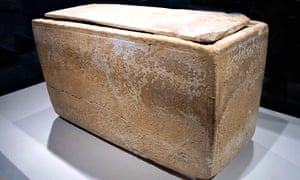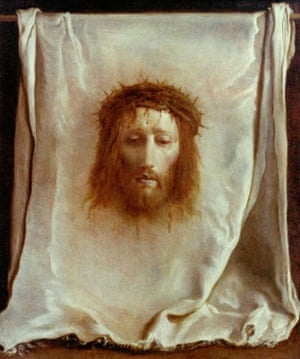New scientific evidence on the tomb of Jesus – and his wife and child – will never be accepted. Religion prefers its relics, like its art, with smoke and mirrors
 An artifact believed to have once contained the bones of Jesus’ brother James on display in Toronto, Canada. Photograph: Drew Cunningham/Getty Images
An artifact believed to have once contained the bones of Jesus’ brother James on display in Toronto, Canada. Photograph: Drew Cunningham/Getty ImagesJonathan Jones
Wednesday 8 April 2015 14.07 BSTLast modified on Wednesday 8 April 201514.09 BST
If only the great arguments between religion and doubt could be settled by scientific evidence. A story this week has it that solid evidence has emerged about the historical Jesus: the “tomb of Jesus” reportedly contains proof that Jesus was married, had a son – and was never resurrected.
So that’s settled then. Or at least it would be if the scholarly world unanimously accepted these claims (which seems unlikely) or if religious belief were grounded in evidence. If that were the case, all religious belief would have disappeared when Charles Lyell uncovered the nature of geological processes and intimated the true age of Earth in the 1830s – the first clear evidence of a godless natural world.
Religion sees only the evidence it wishes to see. This is very apparent in western art. Christian paintings are full of supposed evidence for the divinity of Christ. His real face is purportedly recorded in paintings that faithfully copy his uncannily preserved image.
Long before the Turin shroud became famous, the veil of Saint Veronica fulfilled the function of spookily revealing the “true” face of Christ. According to a widely believed story, Veronica was in the crowd when Jesus carried his cross to Calvary. She wiped the blood and sweat off his face with her veil – it’s known as the sudarium, Latin for sweaty cloth – and his features left a miraculous imprint, like a photograph.

FacebookTwitterPinterest The Veil of Veronica by Domenico Fetti, 1615. Photograph: Francis G Mayer/Corbis
Mythically, the face of Christ in art – with his long hair and beard – is based on this uncanny image. The veil of Veronica appears in many paintings, as proof of Christ’s true appearance. Hans Memling portrayed Veronica holding up her veil and revealing Christ’s face. An anonymous medieval painting in London’s National Gallery similarly shows her revealing the veil’s secret. In the baroque age, artists including Domenico Fetti depicted the veil as an isolated, eerie revelatory object.
There are many more portrayals of the veil of Saint Veronica, not only in Catholic art but in Russian Orthodox icons. Yet almost no one believes in it any more. In fact, it was discredited in 1629, when the pope declared it a fake.
The veil was actually a medieval legend. The middle ages produced physical evidence of Christ and the saints in abundance: every cathedral had its holy fingers, heads, arms or splinters of the true cross. Much medieval art was made to glorify relics. The spectacular stained glass architecture of Sainte-Chapelle in Paris, for instance, was created to house and venerate relics of the passion, including the crown of thorns itself.
Few relics have withstood scientific scrutiny, but the modern age produced its own peculiar piece of Christian “evidence”. The ghostly face revealed by a photographic negative of the Turin shroud in 1898 made this relic suddenly convincing to many eyes – a genuinely inexplicable image. Radiocarbon dating has revealed that it is in fact a medieval fake (as relics tend to be) but the “photographic” quality of the shroud still seduces some.
Christianity, then, does care about evidence – as long as it suits pre-existing beliefs. The mountains of evidence for a universe that works just fine without any divine intervention are easily ignored by anyone who wants to believe in God. Lots of people would rather believe in the veil of Saint Veronica than in a historical Jesus who got married and had a kid.

No comments:
Post a Comment